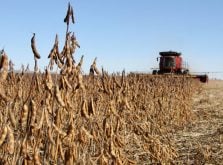The Canadian Grain Commission is examining a potential replacement for the crush and count system, which has been used for decades to determine green seed content in canola samples.
Assistant chief commissioner Jim Smolik said the commission is evaluating a new green seed testing system at country elevators and port facilities in Western Canada.
If the new system proves accurate, it could one day replace the crush and count system and end debates between grain buyers, who often see more green in canola deliveries, and producers, who usually see less.
Read Also

Manitoba extends Crown land rent freeze
Manitoba government links the continued rental rate freeze on grazing and forage leases to economic and environmental challenges facing the industry
“What we’re looking at is … (using) near infrared reflectance (NIR) spectroscopy and that’s hopefully to replace the crush and count system at the elevator,” Smolik said.
“This is something that would have to be driveway ready so that you can ensure that you’re getting a fair representation of what’s on your load.”
The commission has been testing an NIR instrument known as the Instalab 600.
The machine weighs 65 pounds and is manufactured by Dickey-john, which specializes in monitoring systems, electronic controllers, moisture testers, ground speed sensors and GPS systems.
The U.S. company’s promotional material says the Installable 600 can test samples in less than a minute.
The grain commission has installed three of them at country elevators and two more at port facilities.
Smolik said elevator employees will use the machines to test car lots of canola as they are prepared for shipment.
The same car lot would be sampled again when it arrives at port to determine if port values vary significantly from elevator values.
Both samples would then be sent to the grain commission’s head office for a third round of testing.
“What we’re trying to do is … determine if testing at the country elevators is going to be adequate,” Smolik said.
“Is (the system) going to work at country elevators and when the canola gets to port, is it (the chlorophyll level) going to change?”
The project’s goal is to test 500 to 600 samples before making an overall assessment of the new system’s usefulness.
Smolik told farmers last month it is important that test results be consistent.
The program is part of a large plan at the grain commission aimed at reducing dependence on visual assessment methods and moving toward science-based systems that are more accurate and less subjective, he said.
Smolik also provided an update on attempts to provide a rapid assessment of the quality of wheat delivered to country elevators.
The program used a third-generation rapid visco analyzer to examine wheat and assess the quality of flour it produces.
However, Smolik said test results were too variable.
“Unfortunately, it didn’t work for (wheat) but the thing that we did learn is that it may be something, with some tweaking, that we could use in the barley industry to help the malting industry determine pre-sprout … in malt samples.”
The commission is now testing two new technologies for determining wheat quality.
One, based on an enzyme-linked immunosorbent assay (ELISA) system, detects enzymes that are released when a wheat kernel begins to sprout.
Another, a hyperspectral imaging system, can see sprouting that is not visible to the naked eye.
Testing of the ELISA system is more advanced and shows greater promise for the Canadian wheat industry, he said.
“The ELIA project is in partnership with a large multinational corporation and we have completed three projects with increasing complexity using this technology,” he said.















